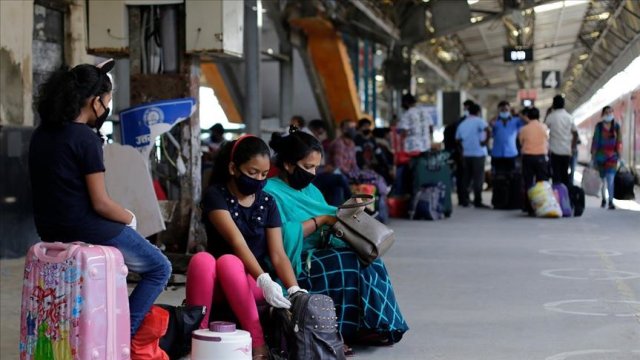Just as nowhere is immune to the effects of climate change, so the Covid-19 pandemic exempts no one, rich or poor, head of state or refugee. But these global crises do not affect everyone in the same way. Vulnerability to the pandemic is linked to risk factors, including age, and its socioeconomic repercussions, like those of global warming, are unevenly spread across the world and within countries, following long-established fault lines between rich and poor, men and women, white and non-white etc. That President Donald Trump caught the virus confirms it has no regard for political rank, but his exceptional medical treatment, costing an estimated $100,000 for three days in hospital [1], makes plain that, while humans may all be equal in the face of illness and death, some, as George Orwell famously put it, are more equal than others.
As ever, the Third World is worst affected by the current economic crisis, which the IMF called the Great Lockdown in its ‘World Economic Outlook’ this April [2]; it is already the most serious crisis since the Great Depression of the 1930s. The Third World — the global third estate that only a few East Asian countries have managed to escape since economist Alfred Sauvy coined the term in 1952 — is defined here as comprising low-income as well as lower-middle and upper-middle income countries, according to the World Bank’s classification (excluding China and Russia, which are both world powers, if only upper-middle income countries).
The Great Lockdown has significantly worsened unemployment internationally, but its social impact is much more pronounced in the Third World than in rich countries, where costly measures have been introduced to mitigate its consequences. According to the International Labour Organization (ILO), of the equivalent of 332 million full-time jobs eliminated globally on average in the first three quarters of 2020 (an 11.7% reduction on the final quarter of 2019), 143 million were in lower-middle income countries (-14%) and 128 million in upper-middle income countries (-11%) compared to 43 million (-9.4%) in rich countries [3]. Low-income countries may have lost ‘only’ the equivalent of 19 million jobs (-9%) in the same period, but this number does not reflect the true social and economic impact they are suffering. In low-income and lower-middle income countries, most jobs and economic activity are in the informal sector, which accounts for 60% of global labour, and therefore have no welfare protection.
A recent World Bank report estimates that in 2020 extreme poverty, defined as subsisting on less than $1.90 a day, has grown as a result of the pandemic for the first time since 1998, when the 1997 Asian financial crisis caused a rise [4]. South Asia is worst affected numerically: between 49 and 56.5 million more people are expected to have entered or remained in extreme poverty this year compared to pre-pandemic projections. The equivalent figure for Sub-Saharan Africa is between 26 and 40 million, confirming its unenviable position as the global region with the highest rate of extreme poverty. For developing countries in East Asia, excluding China, the excess in 2020 will be between 17.6 and 20.7 million, and may be 4.8 million in Latin America and 3.4 million in the Middle East and North Africa [5]. In total, according to the World Bank, between 88 and 115 million more people, when compared to forecasts, will either continue to live on less than $1.90 a day or fall into this category in 2020 because of the pandemic. The net increase in the very poor in 2020, compared to 2019, will be between 60 and 86 million.
The UN’s stark warning
There has been a slowdown in poverty alleviation since 2013, mainly due to accelerating climate change, which targets the poor first, and new conflicts, including those in Syria, Yemen and South Sudan. Now the Great Lockdown has made the UN’s Sustainable Development Goal of reducing extreme poverty globally to 3% by 2030 unachievable. The figure was 10% (736 million) in 2015. According to World Bank estimates, it seems likely that it will still hover at around 7% of the world’s population in 2030.
The UN’s Office for the Coordination of Humanitarian Affairs (OCHA) issued a stark warning in July; Mark Lowcock, UN Under-Secretary-General for Humanitarian Affairs and Emergency Relief Coordinator, summarised the situation in his foreword to the OCHA report: ‘Recent estimates suggest up to 6,000 children could die every day from preventable causes as a result of direct and indirect impacts of Covid-19. Diverted health resources could mean the annual death toll from HIV, tuberculosis and malaria doubling. School closures will undermine productivity, reduce lifetime earnings and widen inequalities. Economic downturn, rising unemployment and reduced school attendance increase the likelihood of civil war, which drives famine and mass displacement’ [6].
Famine has already advanced significantly, even without new wars. The OCHA report says the pandemic has worsened starvation in already affected zones, and also created new epicentres. The number of people in acute food insecurity may reach 270 million by the end of this year, up from 149 million before the pandemic, without urgent, massive food assistance from rich countries. So far, they have failed to deliver: of the $10.3bn the OCHA requested, just $2.5bn had been received by September according to the UN Secretary-General’s annual report [7]. The World Food Programme’s recent million-dollar Nobel peace prize will not plug the gap. On 13 October the World Bank allocated $12bn to developing countries for a Covid-19 vaccination and testing programme. Could the discrepancy be because famine, unlike the virus, isn’t contagious and doesn’t spread across borders with migrants?
In education, the Every Woman, Every Child programme launched by the UN in 2010, and jointly managed by the World Health Organisation and Unicef, warns in its latest report that school closures due to the pandemic mean that many children and young people in the Third World will never return to education, with ‘others potentially exposed to increasing levels of domestic violence and higher risks of early pregnancy’ [8]. The report estimates that the pandemic could reduce by a third the progress towards eliminating gender-based violence by 2030 and cause an additional 13 million child marriages over the next decade.
Legacy of past pandemics
‘It doesn’t have to be like this. It can be fixed with money and leadership from the world’s wealthier nations,’ Lowcock said. ‘We estimate the cost of protecting the poorest 10 per cent of the global population from the worst effects of the pandemic and global recession is US$90 billion — less than 1 per cent of the stimulus package wealthy countries have put in place to protect their own economies.’ According to the IMF, the total cost of the stimulus plans announced worldwide had reached $11.7trn by September 2020, 12% of global GDP, most of it in high-income countries [9]. Rich countries’ level of real public debt now exceeds 120% of GDP, a level reached only once before in the history of capitalism, at the end of the second world war. According to the ILO, $937bn would mitigate the effect of the job losses in lower-middle income countries while low-income countries would need just $45bn: a total of $982bn for the group of states that are home to the great majority of the global population.
The aid needed by poor countries is modest compared to the measures taken by governments in rich countries. It is also urgent. IMF researchers have warned of the crisis’s long-term effects on low-income countries, referring to ‘scarring’, that is the permanent loss of productive capacity caused by job losses: ‘Scarring has been the legacy of past pandemics: mortality; worse health and education outcomes that depress future earnings; the depletion of savings and assets that force firm closures — especially of small enterprises that lack access to credit — and cause irrecoverable production disruptions; and debt overhangs that depress lending to the private sector. For example, in the aftermath of the 2013 Ebola pandemic, Sierra Leone’s economy never recovered to its pre-crisis growth path’ [10].
India, the Third World’s most populous country, is among the worst affected by the Great Lockdown. Its GDP fell by 23.9% in the second quarter of 2020. This was a severe blow to ‘the country’s ambition to become a global power, lift its poor and update its military’, wrote the New York Times’s South Asia bureau chief Jeffrey Gettleman. Erratic management by far-right prime minister Narendra Modi has been a major factor, illustrating the risks of directly copying measures taken in countries with very different social and demographic conditions.
Gettleman wrote, ‘On March 24, at 8pm, after ordering all Indians to stay indoors, Mr Modi shut down the economy — offices, factories, roads, trains, borders between states, just about everything — with four hours’ notice. Tens of millions of Indians lost their jobs instantly. Many worked in factories or on construction sites or in urban homes, but they were migrants from rural India. Fearing they would starve to death in city slums, millions poured out of the urban centres and walked, rode bicycles or hitched desperate rides back to their villages, an epic reverse migration from city to countryside that India had never seen. That dragged coronavirus into every corner of this country of 1.3 billion people’ [11].
India’s middle class has been hit too; 6.6 million white-collar workers have lost their jobs and the suicide rate has increased among managers and independent professionals [12]. The Modi government has responded to this huge crisis with a $10bn stimulus plan, announced on 12 October; compare that to the $2trn plan passed by the US in March, 200 times more for a population a quarter of the size.
On 6 October the IMF’s director general, Kristalina Georgieva, expressed her satisfaction that exceptional measures had enabled the global economy to withstand the effects of lockdown better than expected. If the worst has so far been avoided, Georgieva suggested, it is ‘largely because of extraordinary policy measures that put a floor under the world economy. Governments have provided around $12 trillion in fiscal support to households and firms. And unprecedented monetary policy actions have maintained the flow of credit, helping millions of firms to stay in business’ [13]. But, she added, ‘some were able to do more than others. For advanced economies, it is whatever it takes. Poorer nations strive for whatever is possible.’

Africa the worst affected
Georgieva diagnosed the Third World’s condition: ‘Emerging markets and low-income and fragile states continue to face a precarious situation. They have weaker health systems. They are highly exposed to the most affected sectors, such as tourism and commodity exports. And they are highly dependent on external financing. Abundant liquidity and low interest rates helped many emerging markets to regain access to borrowing — but not a single country in Sub-Saharan Africa has issued external debt since March.’
Africa has once again been worst affected. The African Development Bank (AfDB) estimates that the contraction in growth for 2020 may cost the continent $145-190bn of the $2.59trn GDP forecast pre-pandemic [14]. The bank believes that 2021 will also see a shortfall of $28-47bn compared to pre-pandemic estimates. States ‘with high debt burdens and high dependence on volatile international financial flows’ are especially at risk.
Such flows have been significantly weakened. Besides the global effects of the Great Lockdown on the functioning of their own economies, Third World countries are suffering from knock-on effects of the crisis in rich countries. There has been a drastic drop in a wide range of financial flows and investment going to developing countries, particularly remittances from expatriate workers. An effect of globalisation, from the combination of greater circulation of people and money, is that there has been sustained growth in remittances sent home to low- and middle-income countries by migrant workers since the start of the century. It reached a record $554bn in 2019, for the first time exceeding foreign direct investment (FDI) in developing countries, which has been steadily declining since peaking at over $700bn in 2010 [15]. In the past 20 years, migrants’ remittances have consistently exceeded both portfolio debt and equity flows, and official development assistance (ODA). Migrants’ remittances are now significantly larger than ODA, though the OECD says that in 2019 it reached an all-time high in real terms at $152.8bn [16].
Expatriate workers contribute around 10% of GDP in countries that include many African states, such as Senegal, Zimbabwe, and South Sudan (over 34%); Central Asian former Soviet republics without hydrocarbon resources (nearly 30% in Kyrgyzstan and Tajikistan); Jordan, Yemen, Lebanon and the Palestinian territories in the Middle East; Nepal (27%) and Pakistan and Sri Lanka (both around 8%) in South Asia; the Philippines in East Asia; and Central American states including El Salvador and Honduras (both over 20%), with as much as 37% for Haiti [17].
The World Bank believes that remittances to developing countries will shrink by 20% in 2020, over $110bn, because immigrants have suffered disproportionately from job losses and reduced wages in host countries during the crisis. The UN Conference on Trade and Development (UNCTAD) estimates that FDI in African countries will fall by 25-40% in 2020, having already declined by 10% in 2019 [18]. For developing countries in Asia, which are especially vulnerable to disruption of global supply chains, the drop could be 30-45% and for Latin America, 50%.
Then there is the problem of debt: developing countries’ repayments are at their highest level since 2000 [19]. On average, they are likely to reach 14.3% of these states’ government revenue in 2020, compared to 6.7% in 2010. Many face acute situations, such as Gabon, where debt repayments absorb 59.5% of state revenues, Ghana (50.2%), Angola (46%) and Pakistan (35%). Fifty-five states spend over 15% of their government revenue on debt, compared to 31 in 2018, 27 in 2017 and 22 in 2015.
Few agreements with the G20
In response to this emergency, international financial decision-makers have made frequent professions of good intentions to alleviate the debt burden on Third World countries to help them face the pandemic. They include the World Bank’s president David Malpass, as well as its chief economist Carmen Reinhart, who advocates cancelling debt so that these countries can take on yet more of it [20]. But the reality is less benign, says Éric Toussaint, spokesman for the Committee for the Abolition of Illegitimate Debt (CADTM): ‘In response to the pandemic, the G20 granted a moratorium on bilateral government debt repayments for May-December 2020 ... But although 73 countries were selected, in reality only 42 reached an agreement with the Paris Club’ [21]. Why so few? Toussaint suggests one explanation could be ‘coercion from private creditors and credit ratings agencies’. They have ‘indicated that countries making requests for a moratorium risked having their status downgraded by the ratings agencies and their access to financial markets cut off’. Bottom line: ‘These countries will have to pay back a larger sum with fewer resources’ [22].
Third World countries, feeling squeezed by the crisis, are arguing for more debt relief measures [23]. Revolt is building. In the Financial Times, Ghana’s finance minister Ken Ofori-Atta called on African states to ‘take the lead by establishing a secretariat to coordinate the varied interest groups and centres of power to propose a restructuring of the global financial architecture’ and ‘make it fit for purpose for Africa and other developing countries as we navigate the post-Covid-19 recovery’ [24]. Others, such as the leftwing Filipino academic Walden Bello, advocate that Third World countries adopt a strategy for exiting the twin pillars of the global financial architecture, the IMF and the World Bank [25].
The Great Lockdown, by entrenching the Third World’s subordinate status in the world market’s politico-economic system, will in the end make it even less likely that countries could escape that system without making a clean break with the neoliberal logic that still dominates it. This despite neoliberalism’s clear inability to fulfil the needs of humankind, which increasingly faces all sorts of disasters.




